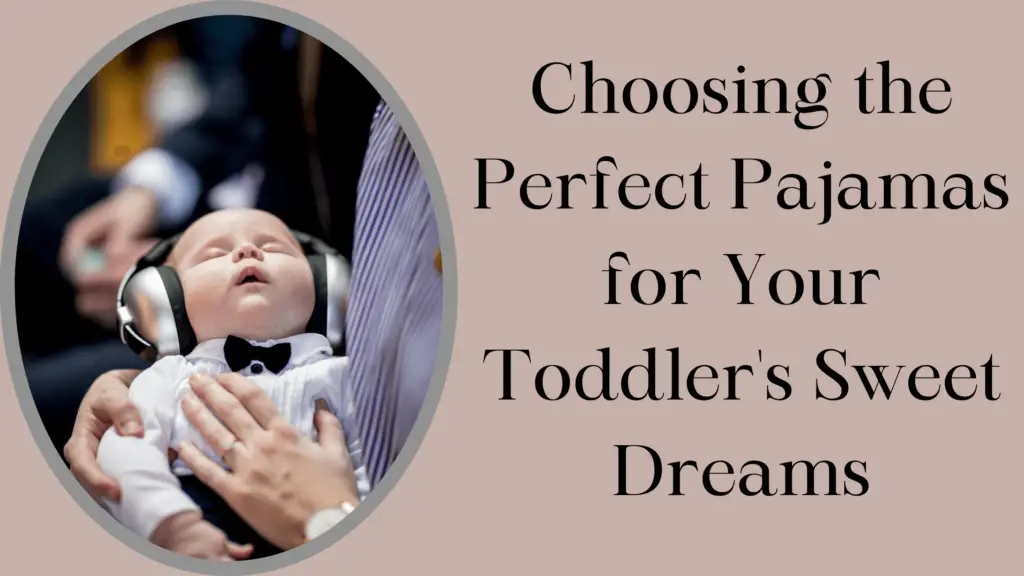As a parent, ensuring your toddler gets a good night’s sleep is a top priority. One often overlooked aspect of this is dressing your toddler appropriately for sleep. The right sleepwear can make a significant difference in your child’s comfort, safety, and quality of sleep. In this comprehensive guide, we’ll delve into the ins and outs of dressing your toddler for sleep, offering practical tips and outfit ideas for various seasons. By the time you finish reading, you will know how to dress toddler for sleep.
But before we continue, here are some ideas on how to dress toddler for sleep that you ought to keep in mind at all time.
- Choose comfortable clothing. Toddlers should be able to move freely and comfortably in their sleepwear. Avoid anything too tight or restrictive, such as leggings or tights.
- Consider the temperature. Dress your toddler in layers so that you can adjust their clothing as needed. If it’s cold, you may want to add a sweater or PJ pants. If it’s hot, you may want to remove a layer.
- Use breathable fabrics. Toddlers sweat a lot, so it’s important to choose sleepwear made from breathable fabrics like cotton or bamboo. This will help them stay cool and comfortable throughout the night.
- Avoid anything with tags or seams. Tags and seams can irritate a toddler’s skin, so it’s best to avoid them in sleepwear. Look for clothing that is tagless and has soft seams.
- Make sure the sleepwear is appropriate for the occasion. If your toddler is going to be sleeping in a cold room, you’ll want to choose warmer sleepwear. If they’re going to be sleeping in a warm room, you can choose lighter sleepwear.
Understanding Your Toddler’s Sleep Needs
Toddler Sleep Stages and Their Impact on Clothing Choices
Toddlers, like adults, go through various sleep stages during the night. These stages can influence how comfortable your child feels in their sleepwear. For instance, during Rapid Eye Movement (REM) sleep, a toddler’s body temperature can fluctuate more than during other stages. Therefore, it’s crucial to choose sleepwear that allows for temperature regulation.
Understanding these sleep stages can help you select appropriate clothing. During REM sleep, your toddler may need lighter sleepwear to prevent overheating, while during deeper sleep stages, they may require slightly warmer options.
Recognizing Signs of Discomfort Due to Improper Dressing
Toddlers might not communicate their discomfort as clearly as adults. Therefore, it’s essential to be vigilant and look for signs that indicate your child might be uncomfortable due to their sleepwear. Common signs include restlessness, frequent waking during the night, or excessive sweating.
If you notice any of these signs, it’s worth reevaluating your toddler’s sleepwear to ensure it’s suitable for their comfort and needs.
The Age and Developmental Stage of Your Toddler
Your toddler’s age and developmental stage can significantly impact their sleepwear requirements. As toddlers grow and develop, their preferences and abilities change. Here are some considerations:
- Young Toddlers: Infants transitioning to toddlerhood may require more assistance with dressing, so choose sleepwear that is easy to put on and take off.
- Older Toddlers: Older toddlers may start expressing preferences for certain types of sleepwear. Involving them in the selection process can help foster a sense of independence and comfort.

Choosing the Right Sleepwear
Fabric Selection for Comfort and Breathability
The choice of fabric for your toddler’s sleepwear plays a pivotal role in their comfort. Opt for materials that are both soft and breathable, such as cotton or bamboo. These fabrics allow air circulation, wick away moisture, and prevent overheating. Additionally, they are gentle on your toddler’s skin and reduce the risk of skin irritation.
Choosing the right fabric is especially critical if your child has sensitive skin or allergies. Always check the label for any allergen-related warnings and ensure that the sleepwear is hypoallergenic.
Appropriate Sizing for Ease of Movement and Safety
The fit of your toddler’s sleepwear is equally important. Sleepwear should be snug enough to keep your child warm but not too tight to restrict movement or circulation. Loose sleepwear can pose tripping hazards, so it’s essential to strike the right balance.
Additionally, avoid sleepwear with small buttons, hooks, or other choking hazards. Opt for sleepwear designed with safety in mind, featuring secure fastenings and no small parts that can come loose.
Seasonal Considerations
Choosing sleepwear that aligns with the season is crucial for your toddler’s comfort. Here’s a more detailed breakdown of seasonal considerations:
Summer Sleepwear
During hot summer nights, lightweight sleepwear is the key to keeping your toddler cool and comfortable. Consider short-sleeved onesies or pajama tops paired with shorts or lightweight pajama pants. These options allow for breathability and prevent overheating.
Winter Sleepwear
For cold winter nights, it’s essential to keep your toddler warm without overheating. Opt for long-sleeved onesies or pajama tops, pajama pants, and socks. Layering can be particularly effective in trapping warmth and ensuring a cozy night’s sleep.
Spring and Fall Sleepwear
Transitional seasons bring fluctuating temperatures. In spring and fall, a long-sleeved onesie or pajama top combined with pajama pants or shorts offers flexibility. This allows you to add or remove layers as the temperature changes throughout the night.
Layering Techniques
The Benefits of Layering for Temperature Regulation
Layering sleepwear is a practical strategy for maintaining your toddler’s comfort throughout the night. Layers allow you to adapt to temperature changes, ensuring your child neither gets too hot nor too cold.
How to Layer Effectively Without Overheating or Underdressing
When layering your toddler’s sleepwear, consider starting with a base layer made from breathable fabric like cotton. This helps wick away moisture from their skin. Over the base layer, add a warmer layer such as a long-sleeved pajama top or a sleep sack. For colder nights, you can introduce a light sweater or blanket for additional warmth.
The key is to monitor your toddler’s comfort during the night and adjust the layers as necessary. Be cautious not to over-layer, as this can lead to overheating and discomfort.
Tips for Choosing the Right Pajama Sets and Sleep Sacks
Selecting the right pajama sets and sleep sacks can make a significant difference in your toddler’s sleep quality. Look for sleepwear designed specifically for your toddler’s age and size. These are tailored to provide the utmost comfort and safety during sleep.
Sleep sacks, in particular, offer a cozy and secure alternative to traditional pajamas. They eliminate the need for loose blankets in the crib, reducing the risk of suffocation.
Using Sleepwear Accessories
Accessories like sleep hats and socks can enhance your toddler’s sleep experience when used appropriately. Sleep hats, for instance, can help retain warmth during colder nights. However, it’s crucial to ensure that these accessories are breathable and do not lead to overheating.
Remember that your toddler’s comfort should always be the top priority when considering sleepwear accessories. If your child appears uncomfortable or restless, it’s essential to assess whether any added accessories are contributing to the issue.
Read About: The Best Sleeping Position for Coughing Baby
Safety First
Guidelines for Safe Sleepwear Choices
Safety is paramount when selecting sleepwear for your toddler. Always prioritize sleepwear that adheres to safety guidelines. Here are some essential considerations:
- Avoid Drawstrings: Sleepwear with drawstrings can pose strangulation hazards. Opt for designs with elasticized waistbands or other safe closures.
- Choking Hazards: Check for small buttons, snaps, or decorations that could detach and become choking hazards. Ensure that sleepwear is free of such small parts.
- Flame Resistance: Look for sleepwear labeled as flame-resistant. This feature adds an extra layer of safety in case of contact with open flames.
- Care Instructions: Follow the care instructions on the sleepwear label to maintain its safety standards. For instance, flame-resistant sleepwear may lose its effectiveness if not cared for properly.
Avoiding Items That Can Pose Risks in the Crib
While sleepwear is essential, it’s equally crucial to keep the crib safe. Remove any toys, pillows, or excess bedding from the crib, as these items can suffocate your toddler or pose other hazards during sleep. The crib should have a firm mattress with a fitted sheet, and the sleepwear should be the primary source of warmth.

Monitoring Room Temperature
Maintaining an appropriate room temperature is crucial for your toddler’s comfort and safety. It’s generally recommended to keep the room temperature between 68-72°F (20-22°C) for optimal sleep. Use a reliable room thermometer to ensure the room remains within this range and adjust your toddler’s clothing accordingly.
If the room is warmer, opt for lighter sleepwear, and if it’s colder, add layers or choose warmer sleepwear options. Remember that keeping the room at a comfortable temperature can reduce the need for excessive layering.
Regularly Checking for Wear and Tear
As your toddler grows and becomes more active, their sleepwear can experience wear and tear. Regularly inspect their sleepwear for signs of damage, such as loose seams, frayed fabric, or worn-out elastic. Damaged sleepwear should be promptly replaced to ensure your child’s safety and comfort.
Tips for a Good Night’s Sleep
Establishing a Bedtime Routine
A consistent bedtime routine helps signal to your toddler that it’s time to sleep. This routine can include calming activities like reading a book, taking a warm bath, or singing a soothing lullaby. A predictable routine can help your toddler relax and prepare for a restful night’s sleep.
The Role of a Comfortable Sleep Environment
In addition to choosing appropriate sleepwear, creating a comfortable sleep environment is essential. Consider the following factors:
- Blackout Curtains: These can help block out excess light, creating a darker and more conducive sleeping environment.
- White Noise Machine: A white noise machine can drown out background noise and provide a soothing background sound that can help your toddler fall asleep and stay asleep.
- Comfortable Mattress: Ensure that your toddler’s mattress is comfortable and appropriate for their age and size. A supportive and cozy mattress is crucial for quality sleep.
How Dressing Appropriately Can Aid Sleep Training Efforts
Properly dressing your toddler for sleep can complement sleep training efforts. When your child is comfortable and not too hot or too cold, they are more likely to self-soothe and sleep through the night. Sleep training often involves teaching your toddler to fall asleep independently and self-soothe when they wake during the night. The right sleepwear can contribute to the overall success of this process.
Troubleshooting Common Sleepwear Challenges
Dealing with Night Sweats and Overheating
Excessive sweating during the night can lead to discomfort and disrupted sleep. To address this issue, consider the following:
- Moisture-Wicking Sleepwear: Look for sleepwear designed to wick moisture away from the skin, keeping your toddler dry and comfortable.
- Adjust Room Temperature: If your toddler sweats excessively, try lowering the room temperature slightly. Cooler room temperatures can help prevent overheating.
- Monitor for Signs of Overheating: Check your toddler’s neck and back for signs of sweating or overheating during the night. If you notice excessive perspiration, adjust their sleepwear accordingly.

Managing Frequent Wake-Ups Due to Discomfort
If your toddler frequently wakes up during the night due to discomfort, it’s essential to address the issue promptly. Here are some steps to consider:
- Assess Sleepwear Fit: Ensure that your toddler’s sleepwear is neither too tight nor too loose. Properly fitting sleepwear reduces discomfort.
- Check Room Temperature: Reevaluate the room temperature and make any necessary adjustments to your toddler’s clothing or bedding.
- Inspect for Irritation: Examine your toddler’s skin for signs of irritation or discomfort. Check for tags, seams, or rough fabric that might be causing issues.
Addressing Growth Spurts and Changing Sleepwear Needs
Toddlers grow rapidly, and their sleepwear needs can change frequently. To accommodate these changes, consider the following:
- Regularly Assess Fit: Check the fit of your toddler’s sleepwear every few months. Ensure that it is still suitable for their size and age.
- Keep Seasonal Changes in Mind: As seasons change, you may need to adjust your toddler’s sleepwear. Be prepared to transition between lightweight and warmer options as needed.
- Donate Outgrown Sleepwear: To prevent clutter and keep your toddler’s sleepwear collection manageable, consider donating outgrown items to families in need.
Read About: How Long Can a Baby Sleep in a Mini Crib
Specific Outfit Ideas for Toddlers
Summer Sleepwear
In the heat of summer, dressing your toddler in appropriate sleepwear is essential to prevent overheating. Consider these outfit ideas:
- Short-Sleeved Onesie or Pajama Top: Choose a short-sleeved onesie or pajama top made from breathable material like cotton.
- Shorts or Lightweight Pajama Pants: Pair the top with shorts or lightweight pajama pants to keep your toddler cool and comfortable.
Winter Sleepwear
When the temperatures drop, it’s crucial to keep your toddler warm and cozy during sleep. Here are outfit ideas for winter nights:
- Long-Sleeved Onesie or Pajama Top: Opt for a long-sleeved onesie or pajama top to provide extra warmth.
- Pajama Pants: Choose pajama pants made from soft, insulating material.
- Socks: Keep your toddler’s feet warm by adding socks to their sleepwear ensemble.
Spring and Fall Sleepwear
Transitional seasons can bring unpredictable temperatures, so versatility is key. Here are outfit ideas for spring and fall:
- Long-Sleeved Onesie or Pajama Top: A long-sleeved top provides a good base layer for cooler nights.
- Pajama Pants or Shorts: Pair the top with pajama pants for cooler evenings or shorts for milder nights.
- Layering Options: Consider adding a light sweater or sleep sack for added warmth when needed.
Conclusion
Dressing your toddler for sleep is a crucial aspect of ensuring their comfort, safety, and quality of sleep. By following these tips and outfit ideas, you can create a sleepwear routine that promotes a good night’s sleep for your toddler. Remember that every child is unique, so be attentive to their individual preferences and needs. A well-rested toddler is not only happier but also allows parents to enjoy a more peaceful night’s sleep. With these guidelines, you can confidently dress your toddler for sleep, contributing to their overall well-being and happiness. Prioritizing your child’s sleep needs and providing appropriate sleepwear sets the stage for restful nights and happy mornings.







